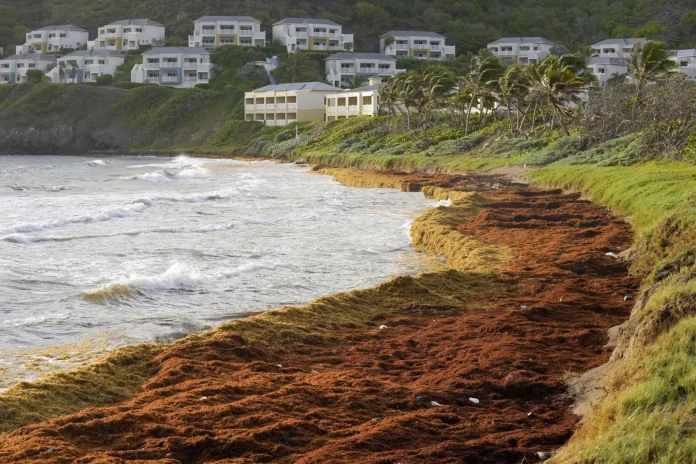A record amount of Sargassum seaweed accumulated in the Caribbean Sea and surrounding areas in May, with even more expected this month, according to a new report.
The brown, spiky algae are choking coastlines from Puerto Rico to Guyana and beyond, disrupting tourism, killing wildlife and even releasing toxic gases that forced a school on the French Caribbean island of Martinique to close temporarily.
According to Brian Barnes, an associate professor at the University of South Florida who worked on a report released Monday by the University of South Florida’s Optical Oceanography Laboratory, the amount — 38 million metric tons — is the largest amount of algae observed in the Caribbean Sea, the western and eastern Atlantic Ocean, and the Gulf of Mexico since the Great Atlantic Sargassum Belt was first studied in 2011.
The previous record was set in June 2022 and was about 22 million metric tons.
“The peaks seem to be getting bigger and bigger every year,” he said. But scientists do not yet know why. “That’s the million-dollar question,” he said. “I don’t have a completely satisfactory answer.”
There are three different species of Sargassum algae in the Caribbean and surrounding areas, which reproduce asexually and remain afloat thanks to tiny air sacs.
They thrive differently depending on sunlight, nutrients and water temperature — factors that scientists are currently studying, Barnes said.
Experts also said agricultural runoff, warming waters and changes in wind, currents and rainfall could be contributing factors.
While large clusters of algae in the open ocean are, according to Barnes, a “healthy and happy ecosystem” for various organisms, from tiny shrimp to endangered sea turtles, sargassum near or on the shore can cause serious damage.
It can block the sunlight needed for coral reefs to survive, and if the algae sinks to the bottom, it can smother reefs and sea grass. Once the algae reaches the shore, the organisms living in it die or become prey to birds, according to Barnes.
Huge piles of smelly algae are also a headache for the Caribbean, where tourism often brings in big money for small islands.
In the popular tourist spot of Punta Cana in the Dominican Republic, authorities have invested in barriers to prevent sargassum from reaching the shore, he said. In the Dutch Caribbean territory of Saint Martin, crews with excavators were dispatched in late May as part of an emergency clean-up after residents complained of strong odours of ammonia and hydrogen sulphide, which can affect the respiratory system.
Meanwhile, in the French Caribbean, authorities plan to use barges for storage and a modernised special vessel that can collect several tonnes of seaweed per day.
In 2018-2019, the amount of Sargassum algae on the beaches of the Caribbean coast of Mexico reached record levels. This forced the Mexican government to take emergency measures and allocate significant funds. The navy was deployed to combat the algae, and “sargassum boats” were purchased to collect the algae at sea before it reached the shore. Municipalities and hotels began installing anti-algae barriers, and the number of workers cleaning the algae from beaches was significantly increased.
Although the exact causes of the abnormal growth of algae in the Atlantic Ocean are still unknown, it is most often associated with the pollution of seawater with organic matter and mineral fertilisers, as well as with the rise in the surface temperature of the world’s oceans.
